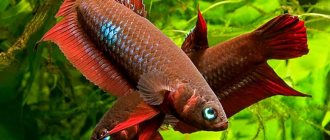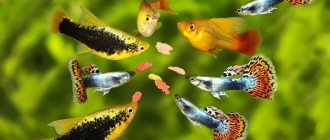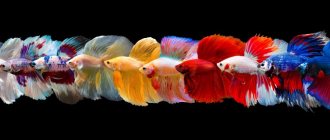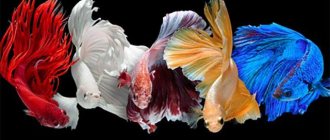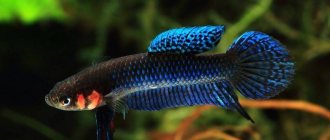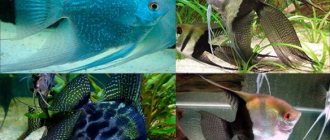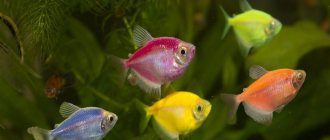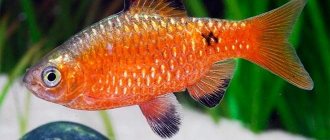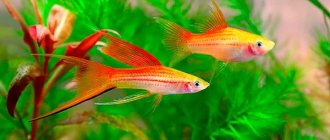FEEDING A COCKER FISH: THE MAIN RULE
In a natural reservoir, the betta fish is in a constant active search for food in order to survive. Aquarium fish do not spend as much energy searching for food, so the amount of food consumed in an aquarium should be several times less.
A caring owner can be confused by the fish’s desire to consume food without stopping. The thought immediately arises that the pet is not eating enough. But the main rule in feeding applies here - it is better not to overfeed than to overfeed! A healthy fish will always eat the entire portion and “ask” for more.
Malnutrition is not as bad for a betta as overeating. In the wild, malnutrition is a common condition for fish. But overfeeding is unnatural and destructive: at best it will lead to obesity, lethargy and shortened life expectancy, and at worst – to death.
Advice!
It is important to choose the right not only food for the fish, but also its size. A betta has a small mouth, so pellets or flakes should be small in size, and large live food should be crushed.
WHAT TO FEED A COCKER FISH
Betta fish are omnivores in the wild.
They consume plant and animal food: they pluck aquatic plants (algae or Java moss), catch insects from the surface of the water or grab them in a jump, eat insect larvae, small crustaceans, worms, look for ground organisms (benthos) at the bottom, etc. When developing a diet for bettas, keep in mind that they need not only plant foods, but also protein.
The standard food for aquarium bettas is artificial dry food (small granules and flakes), which can be purchased at any pet store. Bettas also love live food (fresh, frozen or dried) and plant foods.
This does not mean that there should be a lot of food. For a cockerel, it is better to choose several types of food and feed them alternately.
Advice!
For one feeding - one type of food. There is no need to combine different types of feed. For example, frozen foods should not be given at the same time as dry foods.
Ready-made dry food
Ready-made dry mixes ( pellets, flakes
) are fish feeds that are balanced in their composition. They can be bought at a pet store, they are inexpensive and easy to use and store.
Is it possible to constantly feed a betta fish with dry mixtures? Experts have different opinions.
Most argue that for the normal functioning of an aquarium fish, in addition to dry food, it is necessary to provide live food, since bettas in the wild consume a lot of proteins.
Some experts say that ready-made mixtures are sufficient in the diet of bettas, since manufacturers develop feed compositions that are as close as possible to the biological needs of these fighting fish. The choice is up to the aquarist. We adhere to the first opinion.
1.1
.
Special pellets for bettas
What are granules?
Granules are a type of ready-made food in which all useful substances are balanced, nutritional value is preserved as much as possible with minimal addition of preservatives and stabilizers. They are nutritious, safe, inexpensive and easy to store.
There are different types of pellets, but it is worth choosing those that are designed specifically for bettas ( Betta splendens
).
Betta pellets can be fed daily and are suitable as a main food.
Advice!
The protein content of granulated food for cockerels should be at least 40%.
1.2.Fish flakes
Fish flakes are another type of prepared fish food that comes in the form of thin, lightweight plates. They are suitable for fish living in the upper and middle layers of water, as due to their light weight they float on the surface of the water. The flakes get soggy quickly, making them great for small-mouthed fish like bettas.
The flakes are sold in pet stores and are inexpensive.
On sale you can find flakes of different compositions, colors and sizes. If you feed your betta mainly only flakes, then you need flakes recommended for daily feeding of bettas. If you feed your fish with flakes in addition to the main menu, you can take a fortified composition.
However, many experienced aquarists do not recommend giving flakes to your betta every day, but only as an addition to the main food.
Advice!
Tropical and goldfish flakes are not suitable for betta fish.
Live food
Cockerels are small predators that consume a lot of protein food in natural bodies of water. Live fish food is needed for energy, and it is also a favorite treat for bettas.
Live food can be fresh, frozen or dried. It can be found year-round in pet stores or in a regular fishing store.
2.1.Fresh live food
Most often, common bloodworms, brine shrimp, daphnia, raspberries, earthworms or flatworms are chosen to feed betta fish. Siamese cockerels will not refuse live insects and their larvae, snails, zooplankton or ground seafood.
The most common live food is bloodworms. It can be bought in different sizes. In order for the cockerel to cope with its food, you need to choose the smallest bloodworm.
In the summer, some aquarists, wanting to pamper their pets, catch various aquatic inhabitants in reservoirs. We do not recommend doing this, because there are many cases where, along with such delicacies, parasites were introduced directly from the reservoir into the aquarium and the fish died.
But not only self-caught live food is fraught with danger. Worms, bloodworms and other purchased live food may be contaminated. As a result, an infection is introduced into the aquarium. In our opinion, it is better not to risk it, but to freeze it.
Advice!
Live tubifex often carries parasites or bacteria and is best avoided when alive.
2.2.Frozen live food
As already noted, the protein component in the diet for energy is important for cockerels, and they also love live food. And frozen food is the same as live food, with the same properties, only much safer.
When frozen, bettas eat the following: bloodworms, brine shrimp, daphnia, tubifex worms, glass worms, earthworms, shrimp and beef heart.
You can catch a lot of it yourself or buy a small batch from a supplier and put it in the freezer to freeze. Products must be fresh and clean.
When feeding, you just need to chop off the required amount of food, and return the rest back to the freezer. The cockerel will definitely appreciate this food.
Advice!
Do not defrost or re-freeze live food, as such food loses its beneficial properties and becomes unsuitable for consumption.
2.3.Dried live food
Dried and processed bloodworms, tubifex, brine shrimp and others are available in most pet stores.
You can feed your betta with this dry food often; it is suitable as a daily food.
Plant food
Plant food is given in the form of scalded lettuce leaves.
COCKER FISH: MAINTENANCE AND CARE
What are the diseases and how to treat betta fish?
The betta aquarium fish needs full care and proper housing conditions. If these rules are not followed, the fish may get sick, which will lead to negative consequences. Diseases are easily transmitted to other fish that live in the same aquarium with the betta, even if it is divided into two halves by a partition. Treatment is simplified if she initially lives in a separate tank. If you observe: changes in the appearance, behavior and physiology of your pets, these may be symptoms of their illness.
- Did the symptoms of the disease appear quickly, suddenly, and were they found in other fish? Then the reason is the quality of the aquarium water. What to do: measure water parameters using a water thermometer, litmus paper, and pH value. Find out the indicators of ammonia, nitrates and nitrites, temperature, CO2, oxygen. Be sure to replace the water with fresh and clean water.
- If symptoms of the disease appear in all fish, or in fish of the same species, it means that their body is susceptible to infection. What to do: transplant sick fish into a quarantine tank, do an examination, diagnose all symptoms, and establish a diagnosis. Then you can treat.
Fin rot (Latin name: Aeromonas, Pseudomonas, Vibrio)
A terrible fish disease that can affect bettas. Their fins are affected by pathogenic bacteria, which completely destroy the structure of the fin. Symptoms of the disease: clouding of the fins, their gluing, the appearance of a white border, there are ulcers at the base of the fins, the cornea of the eyes may become cloudy.
The main cause of the disease is improper care of the tank. A betta fish may get sick if:
- The fish aquarium is overcrowded;
- Water changes are made rarely or not at all;
- Residues of food are not removed from the soil, and the bottom is not siphoned;
- The filter is not working well or is dirty;
- The new neighbors of the betta were not in quarantine, or the bettas were placed in an aquarium with sick fish.
See how to treat fin rot.
Even in a seemingly ideal aquarium, a betta fish can get sick. Fin rot is an infectious disease that is found almost everywhere, and in a favorable environment it develops rapidly. Treatment of fish is permissible with the use of antifungal and antibacterial drugs, which allow limiting the growth of bacteria in a matter of days, after which the fish can be fully treated. Preparations for the treatment of fin rot in cockerels: malachite green, Sera Baktopur, streptocide 1.5 g per 10 liters of water (baths), Tetra GeneralTonic (Tetra), Antipar, Fiosept, Tripaflavin. Salt baths can be used for treatment: for a betta, 7-10 grams of table salt per 1 liter of water. They can be done for 30 minutes a day. All preparations for fish must be used according to the instructions for use.
Ichthyophthiriasis, or “semolina”
Oodiniosis, or “velveteen disease”
Oodinum flagellum is the causative agent of the disease. The reasons for their spread are cool water, new neighbors who have not been quarantined, and poor cleaning of the aquarium. When a fish is sick, gray or golden nodules form on the edges of its fins. Then the scales peel off and the fins stick together. A sick fish breathes poorly, does not eat, moves in jerks, and rubs against the bottom. The betta fish, along with other fish, must undergo treatment in a quarantine tank with heated water temperature. They are treated with Sera oodinopur, JBL Oodinol, Tetra Medika General Tonic, Ichthyofor, Formamed or Antipar according to the instructions. Also replace the water for the fish with clean water and treat all decorations and plants.
See also: Aquarium species of cockerels, Compatibility of cockerels with other fish and aquarium inhabitants.
AkvariumnyeRybki.ru>
HOW MUCH FOOD SHOULD I GIVE A COCKER FISH?
All fish are individual and no one can definitely tell you the exact dosage.
You can usually find the following recommendations :
- if we are talking about granules, then give 1-2 pieces per feeding,
- if it’s flakes, then 2-3 medium-sized pieces per meal are enough,
- if you feed bloodworms (live or frozen), then 3 worms per day are enough for one fish.
There is no need to make the portions large. They should be eaten as quickly as possible and absorbed completely.
Advice! Don't forget to clean up leftover food every time after feeding. Uneaten food sinks to the bottom of the aquarium and begins to decompose, releasing ammonia, which will poison the aquarium and cause the fish to feel worse.
Experts have found that for normal life, a betta fish needs to eat only 5% of its body weight in food per day. Everything else is unnecessary for him and can lead to obesity.
Experienced aquarists believe that a betta should be given as much food as he will eat in 2 minutes. Serving size is determined by experiment. Place 4-5 grains of food on the surface of the water and see how much he can eat in 2 minutes. This will be the norm for your betta. The rest needs to be fished out of the water.
But do not forget that often cockerels do not know limits and are ready to eat everything that is given to them. In this case, the 2 minute rule will not help determine the portion.
Advice!
Examine the betta's abdomen in the area of the pelvic fins. If you find an unnatural bulge there, this means that the fish is overeating and you need to urgently review its diet.
HOW OFTEN TO FEED A COCKER FISH
Diet is also important
.
In an aquarium environment, bettas do not require much energy. Therefore, it is enough to feed the betta fish 1-2 times a day in small portions. During the spawning period they need a little more energy and the fish are fed 2 times a day. As your cockerel ages, you can feed him less often, once a day.
As already noted, leftover food should be removed immediately after feeding, since it not only pollutes the aquarium, but also harms the health and coloration of the betta.
Many aquarists advise giving bettas “ unloading”
» days 1 time per week by selecting a specific day. This way, the digestive system will be able to recover, and the fish’s body will have time to get rid of accumulated toxins. Overeating is much worse for these fish than undereating. After the fasting day, the cockerel begins to be fed in very small quantities, gradually increasing the dose of food.
What to give your aquarium pet
It is desirable for the diet of a domestic animal to be similar in composition to that of a wild animal. In aquarium conditions, you can feed your domestic betta with different “dishes”.
We recommend reading
Keeping and caring for discus fish
First of all, these are dry flakes. They are healthy, nutritious, and fortified. But, nevertheless, they cannot be used as the basis of the diet. It is advisable to give this food no more than twice a week.
Second, use a pelleted food formulated specifically for bettas. Suitable for daily feeding.
Of course, live food is useful: brine shrimp, bloodworms, and the like. Suitable for frequent feeding, but should not become the mainstay of the diet.
A good option is frozen protein products (brine shrimp, tubifex, shrimp). Suitable for frequent feeding, useful for cockerels. Food should only be defrosted for one meal and cannot be re-frozen.
When choosing fish food from the above list, include a little of everything in the diet, then your pet’s nutrition will be balanced.
DOES A COCKER NEED VITAMINS?
Constantly giving vitamins to aquarium fish does not make sense. Vitamins are given to fish only in some cases. For example, if the fish is stressed due to a move, the addition of a new resident to the aquarium, or the death of an old resident.
In these cases, to support the betta, you can purchase special vitamins for fish at a pet store and give them according to the instructions. There are additives that are simply added to the aquarium water or those that are included directly in the fish’s menu.
FEEDING COCKER FRY
The diet of betta fry differs from that of adult fish. In nature, babies eat plankton.
What to feed betta fry in an aquarium. Fry that have just emerged from larval age are fed live dust, which consists of tiny microorganisms. You can buy it at a pet store.
After about 2 weeks of life, plankton and fresh brine shrimp larvae can be given. When the size of the betta fry increases, they are given bloodworms and brine shrimp. As your fish grows, you can try feeding dry food. Pet stores sell special food for fry.
Due to their accelerated metabolism and rapid growth, the feeding frequency of young individuals should be every few hours.
Feed selection
Before feeding your betta fish, it is very important to decide on the type of food. Let's look at the main food options.
Granules
This type of food is considered the most common, “everyday” option, suitable for fish of any age, gender and health level. Most often, aquarium fish are fed this food daily. The granules have an ideal price/quality ratio. However, sometimes it is necessary to add variety to the diet, because daily consumption of the same food can provoke a number of diseases and negative changes in the animal’s body.
Alive
This food is a delicacy for all aquarium inhabitants. This type of food is the most preferable, but it must be taken into account that it can carry many dangerous bacteria, viruses, fungi and other pathogens.
The best varieties of this type of food:
- small crustaceans (Artemia, Daphnia, Gammarus);
- bloodworm;
- various benthic (bottom) worms;
- mosquito larvae – very rare.
In nature, betta fish happily eat insects that have fallen into the water.
Dry
Dried live food is no less popular when compiling the daily diet of pets. For young fish, this type is even preferable to granules, because the dried bodies of crustaceans can be ground almost into dust or poured out whole, so for each size of fish you can independently prepare the perfect pieces so that your pet does not choke. As in the case of granules, other components of the diet are required for variety - dry food cannot be fed to your pets every day.
Frozen
It is an improved analogue of a living one, because in this case all pathogenic microorganisms and parasites that lived in crustaceans die. Even infections found in worms, bloodworms and insect larvae can be disinfected by freezing.
However, you need to follow the rules so as not to provoke a cold in your pets: before placing food in the water, it must be defrosted so as not to sharply lower the temperature of the environment in the aquarium. At the same time, the food should not be left defrosted for a long time so that it does not go rotten. The risk of rapid deterioration of the material is especially high in the summer, when air temperatures can reach critical levels.
Specialty cereals
Such flakes are a good substitute for animal and plant components of the diet. It is not always possible to feed fresh scalded greens to your bettas, but flakes are a good substitute for plant fiber. Such flakes are suitable as a delicacy for occasional feeding; they should not be a regular part of the diet.

